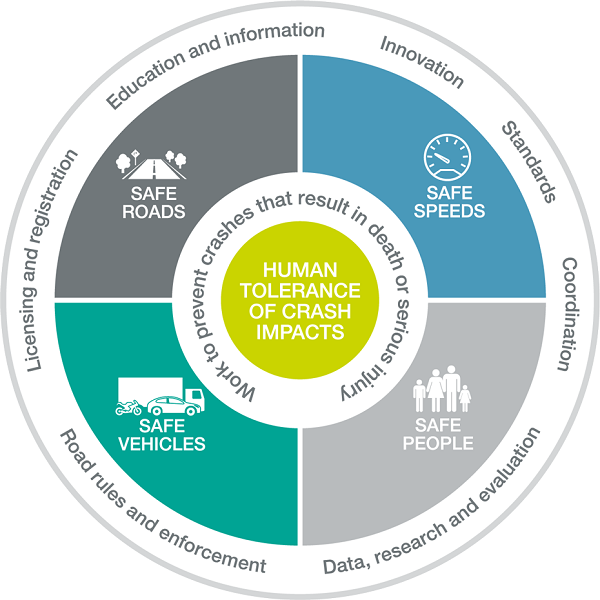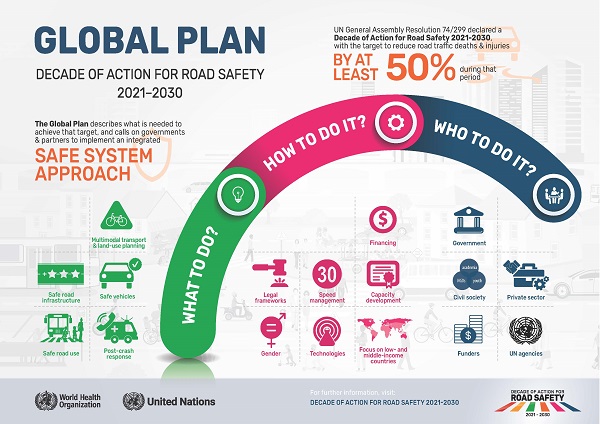





Safe System Approach
The Safe System approach underpins all aspects of an effective road safety management system. The approach is built on the premise that no one should be killed or seriously injured while using the road network.
The Safe System approach recognises that humans are fallible and will make mistakes. There are also limits to the kinetic energy exchange which humans can tolerate (e.g. during the rapid deceleration associated with a crash) before serious injury or death occurs. A key part of the Safe System approach requires that the road system be designed to take account of these errors and vulnerabilities so that road users can avoid serious injury or death on the road. A Safe System approach has the following characteristics:
Mistakes, errors of judgment and poor decisions are intrinsic to humans. The road system needs to be designed and operated to account for this.
Humans are fragile. Unprotected, we cannot survive impacts that occur at greater than around 30km/h.
The ‘engineered’ elements of the system – vehicles and roads – can be designed to be compatible with the human element, recognising that while crashes might occur, the total system can be designed to minimise harm, particularly by making roads self-explaining and forgiving of human error.
Road safety is a responsibility shared between those who use roads and those who manage, design, build and maintain the road system and those who provide post crash care.
In a Safe System, road safety problems are treated by considering the interaction of several components of the transport system, rather than by implementing individual countermeasures in relative isolation. This means that the full range of solutions, infrastructure, traffic and speed management, vehicle standards and equipment and road user behaviour need to be addressed.
Implementing the Safe System approach requires developing and strengthening a country’s institutional management capacity to focus on achieving results aimed at elimination of deaths and serious injuries.
The Safe System Approach evolved from Sweden’s Vision Zero Approach and Sustainable Safety in the Netherlands.
A targeted approach towards this ambition is recommended in the OECD report that focuses on setting and achieving ambitious road safety targets within a Safe Systems approach. This report builds on the key recommendations of the World report on Road Traffic Injury Prevention that set out the strategic initiatives necessary to improve country road safety performance. These are to:
Identify a lead agency in government to guide the national road safety effort.
Assess the problem, policies and institutional settings relating to road traffic injury and the capacity for road traffic injury prevention in each country.
Prepare a national road safety strategy and plan of action.
Allocate financial and human resources to address the problem.
Implement specific actions to prevent road traffic crashes, minimize injuries and their consequences and evaluate the impact of these actions.
Support the development of national capacity and international cooperation.
Guidelines for implementing the World Report recommendations have been developed in a report from the World Bank Global Road Safety Facility. This report discusses road safety management capacity reviews and Safe Systems projects, and provides detailed guidance for the management and investment framework that is necessary to support the successful implementation of the World Report recommendations. The guidelines specify two key stages for implementation:
Stage 1 – conduct a country capacity review that addresses recommendations 1-4 and specifies an investment strategy and identifies Safe System implementation projects.
Stage 2 – prepare and implement Safe System projects based on good practice solutions that address priorities, and build monitoring and evaluation procedures.
Case Studies
Related Images
 Australian National Road Safety Strategy. Image credit: Australian National Road Safety Strategy
Australian National Road Safety Strategy. Image credit: Australian National Road Safety Strategy Global Plan Infographic - for the Decade of Action for Road Safety 2021 - 2030. Image credit: WHO/UN
Global Plan Infographic - for the Decade of Action for Road Safety 2021 - 2030. Image credit: WHO/UN








